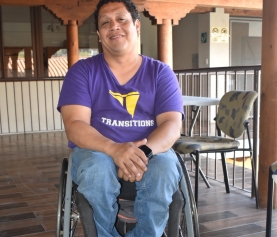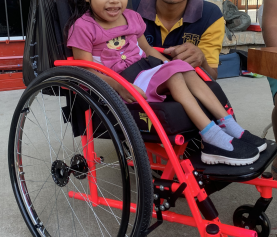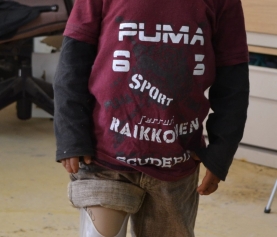Transitions Foundation and MIT teamed up in January to help create a better wheelchair for disabled people living in the Third World.
Transiciónes y MIT trabajaban juntos en enero para crear una versión mejor de la silla de ruedas.
Amos Winter, a post doctorate research associate at MIT, spent the month in Antigua to work with members of Transitions to test a new wheelchair design he invented called the LFC (Leveraged Freedom Chair). Dan Dorsch, an undergraduate mechanical engineering student at MIT, accompanied him to Transitions to serve as an assistant researcher on the project.
Amos Winter de MIT pasó el mes en Antigua para trabajar con miembros de Transiciónes y probar un nuevo diseño para la silla de ruedas él inventó se llama el LFC. Tambien vino Dan Dorsch, un estudiante de MIT, para ayudar con la investigación del proyecto.
The LFC is designed to make the rough conditions people in wheelchairs often encounter in countries like Guatemala much more manageable to navigate. The technology and robotic devices resulting from this work are based on the burrowing mechanisms of razor clams.
El LFC ha estado diseñado hacer más facil navigar las condiciones dificiles se encuentra la gente en las calles de Guatemala.
Winter’s chair has a lever connected to a single-speed bicycle drive train on each wheel. Users grab high on the levers to obtain a long lever arm in order to produce a lot of torque at the wheel and push in a bench press motion. That high degree of leverage enables them to travel through mud, sand or cobblestoned streets. Users can also travel much faster in the LFC by sliding their hands down the levers, closer to the pivot to make the drive train spin at a faster speed.
La silla inventado por Winter tiene dos palancas conectadas a las ruedas. Los usarios se necesitan agarrar la parte superior de las palancas para obtener el punto correcto para producir suficiente tracción a la rueda y empujar. La tracción se permite el usario cruzar fácilmente el lodo, la arena o las calles guijarras. También los usarios se pueden viajar mucho más rapido con el LFC por bajando las manos en las palancas, más cerca de la rueda, y empujando.
“People are going so fast on dirt roads that we have to jog after them during our testing. It is very exciting,” said Winter. “Cruz (a disabled Guatemalan from a rural area) is telling us he can go anywhere now, because it mobility has really increased.”
Todo el mundo está yendo tan rapido sobre las pistas de tierra que nosotros tenemos que correr para seguirlos mientras estamos haciendo las pruebas. Es emocionante,” según Winter. “Cruz, un muchacho discapacitado de las fincas rústicas, nos dijo que él puede ir al cualquier lugar ahora porque el LFC ha aumentado muchisimo la velocidad y la movilidad.
Winter said the first wheelchair was invented in the 1860s, and that basic model has not changed dramatically. He added the hospital style wheelchair that debuted in the 1940s is the most common wheelchair donated in the Third World, despite its inefficiency in those environments.
Winter dijo que la primera silla de ruedas fue inventado hace 150 años, y eso modelo básico no ha cambiado mucho desde entonces. Según a él, el estilo hospital de silla de ruedas fue inventado alrededor 1940, y es la más común donada a la pobreza a pesar de la ineficiencia del estilo.
“The LFC is much more usable,” said Winter. “It weighs about the same and is slightly narrower but much more stable. It is a better hill climber, it looks nicer and it provides a lot better support for people with spinal injuries.”
Winter dijo: “El LFC es mucho más usable. Pesa el mismo como una silla normal pero es más estable. Es mejor para subir cerros, parece más moderna y tiene mucho más apoyo para las personas con lesiónes a la columna.
Winter compares this addition to the wheelchair with the advent of the mountain bike.
Winter compara la agregación de las palancas a la silla de ruedas a la invención de la bicicleta de montaña.
“It is kind of like the invention of the mountain bike as a modifications of a regular bicycle. It opens up the possibility of traveling on all kinds of roads rather than just pavement,” he said. “The benefits are very clear, both watching how they perform and from listening to their feedback. People really like how it goes off road, on cobblestones and hills. People really like the way it feels.”
“Es como la invención de la bicicleta de montaña … Ahora hay posibilidades de viajar sobre todas las calles,” él dijo. “Hay muchos beneficios yo vi de ver los discapacitados en silla y de escuchar a sus realimentaciónes. Todo el mundo le gusta usar la silla.






